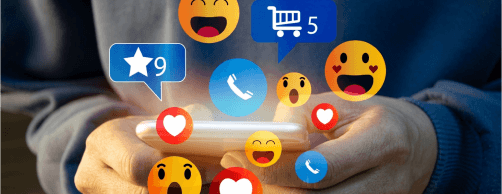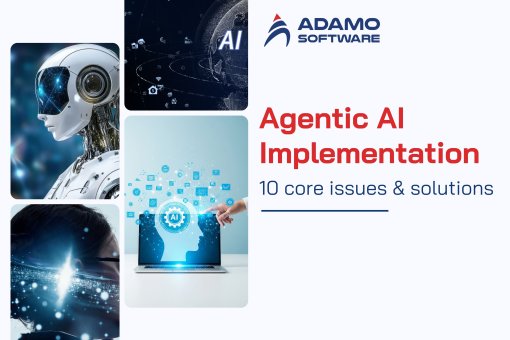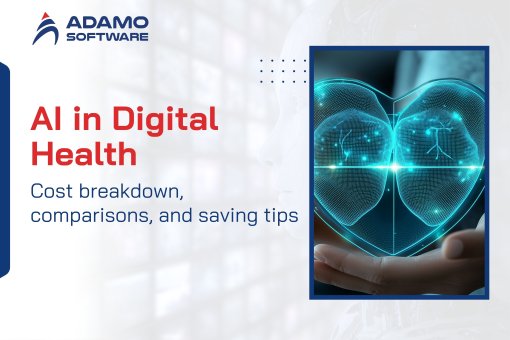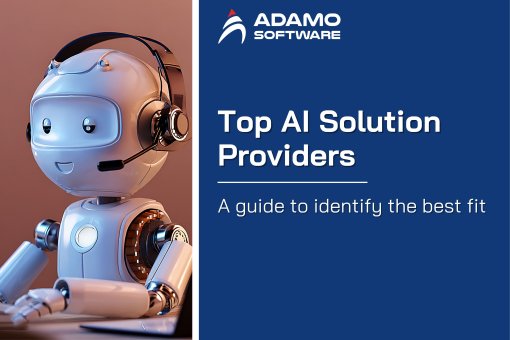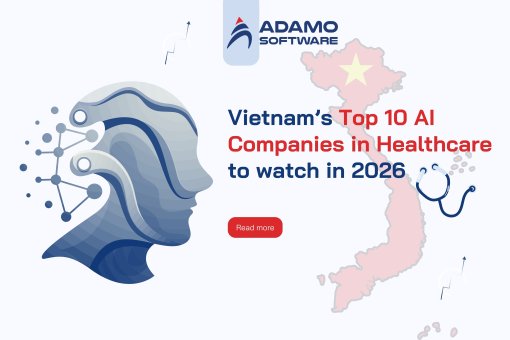OCR in healthcare: Benefits, challenges, and common use cases
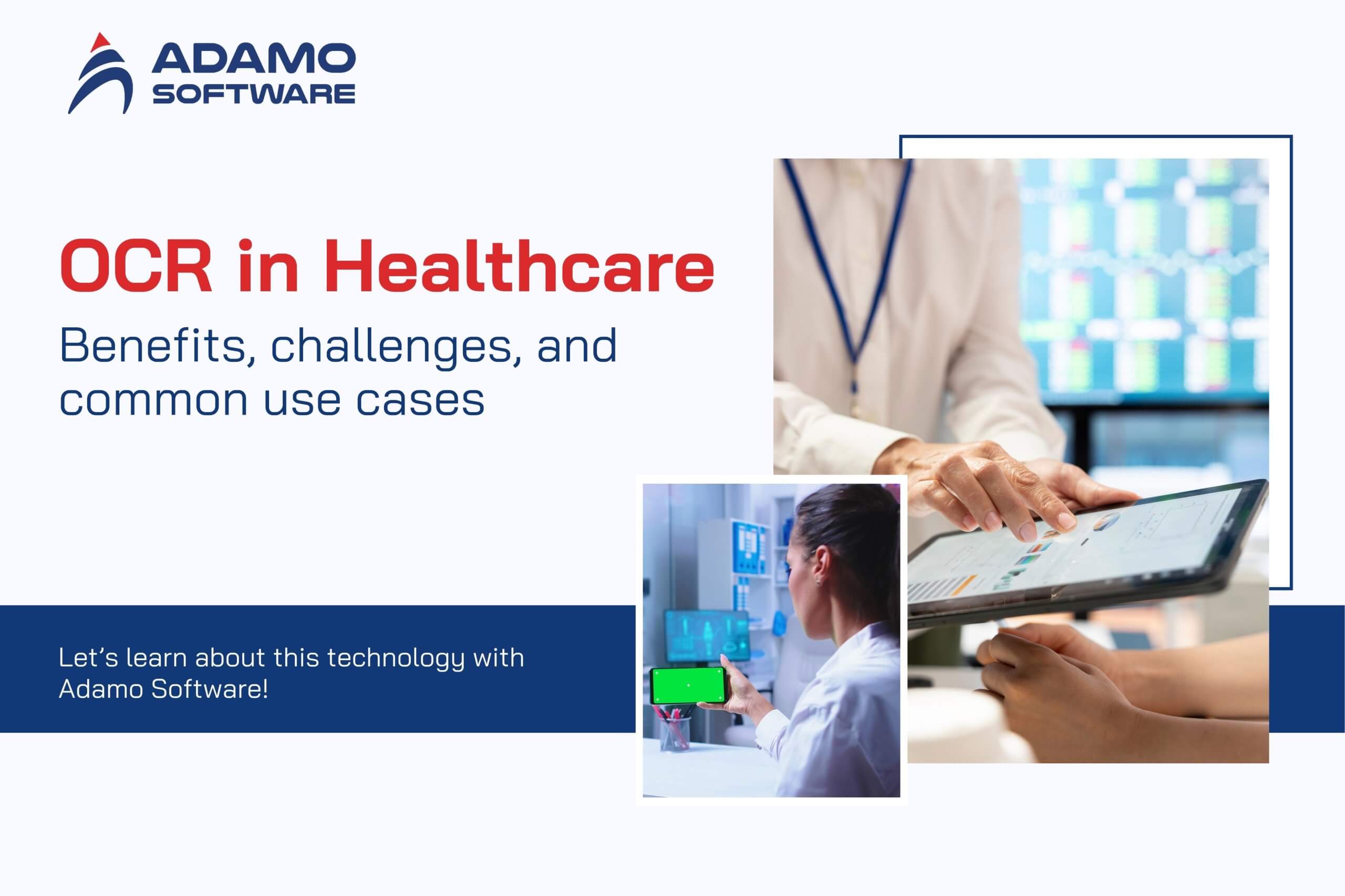
OCR in healthcare helps to address challenges caused by traditional manual data management. Let’s learn about this technology with Adamo Software!
Currently, the healthcare industry is getting more popular with using AI tools and technologies to improve medical outcomes. Traditional manual data management in healthcare is often time-consuming, prone to errors, and inefficient. OCR, standing for Optical Character Recognition, helps to address these challenges by automating the process. Let’s learn about OCR in healthcare with Adamo Software!
Through this blog post, you will find out these following pieces of information.
- What is OCR in healthcare?
- Significant benefits of OCR in healthcare
- Challenges of OCR in healthcare
- Exploring common OCR use cases in healthcare
All information has been thoroughly researched and updated to the latest trends. So, let’s read our blog post and find some useful information!
I. What is OCR in healthcare?
Optical Character Recognition (OCR) is a technology that digitalizes physical medical documents, enhancing data accuracy and efficiency in healthcare. Organizations use OCR in healthcare to scan and convert printed and handwritten medical documents, such as patient forms and lab results, into digital data.
By converting physical documents into digital files, this process enables medical information to be stored, managed, and accessed electronically, which is fundamental to modern healthcare operations. This makes it easier to store and manage healthcare information, creating a structured database for the data. With this data stored in databases, it’s easier to access and analyze, allowing for valuable insights to be drawn from a patient’s medical history. Here’s how OCR in healthcare works.
- Scanning and Character Isolation: The text in the image is scanned, and a specialized program separates each individual character.
- Character Recognition: Each character is then matched against a database of known characters to be identified.
- Text Reconstruction: The recognized characters are reassembled to form a complete text.
- Digital File Creation: Finally, a new digital file containing all the same information as the original document is generated.
Generally, OCR in healthcare technology helps digitize paper medical documents, thereby improving data accuracy and efficiency in medical information management. By converting documents into electronic data, OCR allows for easier storage, retrieval, and analysis of patient information, supporting modern healthcare operations.
II. Significant benefits of OCR in healthcare
By automating data extraction and digitizing medical records, OCR improves efficiency, accuracy, and patient care. Let’s explore some outstanding benefits of OCR in healthcare with Adamo Software!
Here are some notable advantages of OCR in healthcare.
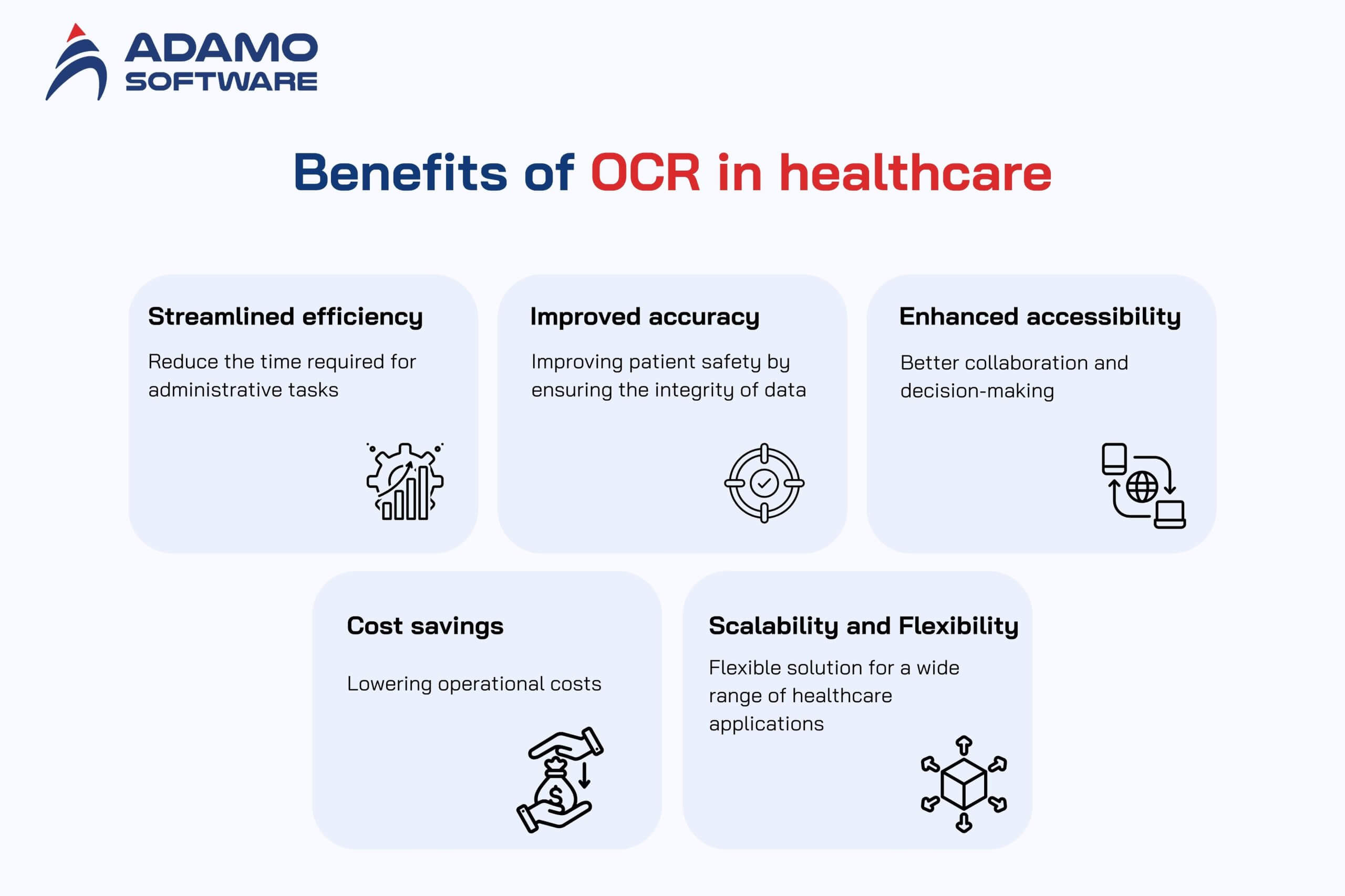
- Streamlined efficiency – Reducing the time required for administrative tasks
- Improved accuracy – Improving patient safety by ensuring the integrity of data
- Enhanced accessibility – Better collaboration and decision-making
- Cost savings – Lowering operational costs
- Scalability and Flexibility – Flexible solution for a wide range of healthcare applications
Let’s find how OCR in healthcare helps in each case!
1. Streamlined efficiency
By automatically extracting and digitizing information from sources like printed forms and handwritten notes, OCR significantly reduces or eliminates the need for manual data entry. This automation significantly reduces the time to process administrative tasks and human errors, ensuring the accuracy and consistency of medical data. Thanks to this, healthcare facilities can optimize resources, save time, and focus more on providing high-quality medical services to patients, instead of having to deal with complex paperwork.
Besides, the application of OCR in healthcare also helps improve data retrieval, supports rapid information analysis and makes more accurate clinical decisions. This plays an important role in improving operational efficiency and overall healthcare quality.
2. Improved accuracy
Besides streamlining efficiency, adopting OCR in healthcare also helps healthcare facilities in improving accuracy in patient treatment. The advanced OCR leverages AI and machine learning technology to achieve high accuracy, even in cases where complex medical terminology or illegible handwriting is encountered.
Thanks to the ability to learn and improve continuously, these systems can recognize characters in a variety of contexts, minimizing errors in the processing of medical data. This is crucial for managing patient records, prescriptions, and billing, where even a small error can have serious consequences. By improving data integrity and reducing errors, OCR in healthcare not only enhances accuracy but also contributes to patient safety and increases efficiency in managing healthcare facilities.
3. Enhanced Accessibility
With OCR in healthcare technology, digitized records are easier to search for and accessible from any department and location in the healthcare system. This eliminates the need to search for paper records and ensures that important information is available when needed. Healthcare specialists, physicians, and staff can collaborate more efficiently with seamless access to information, facilitating the quick and accurate sharing of patient records, test results, and treatment plans.
Especially in emergency situations such as emergency care, this plays an important role, helping to shorten decision-making time and increase the chance of saving the patient. Besides, this connection also contributes to improving the working efficiency of the entire healthcare system, ensuring that all procedures are carried out quickly, transparently and accurately.
4. Cost savings
OCR in healthcare significantly reduces operational costs for healthcare facilities by automating labor-intensive and time-consuming processes, such as manual data entry or paper document processing. By eliminating or minimizing manual steps, hospitals and clinics can save on personnel costs, reduce the risk of errors, and optimize resources to focus on patient care activities. In addition, converting paper records to digital form also significantly reduces the need for physical storage, saving space and costs for maintaining traditional records.
Moreover, by digitizing data, OCR in healthcare speeds up and increases the accuracy of insurance claim processing. This, in turn, accelerates payments and improves the cash flow of medical facilities. This not only increases transparency but also creates financial stability, allowing medical units to invest more in technology, human resources and high-quality healthcare services.
5. Scalability and Flexibility
Modern OCR in healthcare solutions are highly flexible and can be scaled to fit the needs of diverse healthcare environments, from a single clinic to an expansive hospital network. Thanks to this flexibility, OCR solutions can be easily integrated into existing systems without disrupting operational processes, while also accommodating future expansion needs.
More than a simple tool for digitization, OCR technology is transforming how healthcare operations are managed. OCR empowers healthcare providers to enhance care delivery and reduce costs by improving data management and eliminating inefficiencies. This creates a better experience for both staff and patients.
In conclusion, by automating manual processes, OCR improves efficiency, reduces errors, and provides faster access to critical patient information. This allows healthcare providers to streamline operations, focus more on patient care, and keep up with the demands of a fast-paced industry.
Through advanced features like automated data extraction, real-time access, and scalability, OCR in healthcare helps to deliver better, safer, and more efficient services. It adapts to the complex needs of the industry, not just solving problems but also paving the way for a more innovative and patient-centered future.
Explore Our Tailor-made Software Development Solutions
We are confident in providing end-to-end software development services from fully-functioned prototype to design, MVP development and deployment.
III. Challenges of OCR in healthcare
Despite the benefits, OCR in healthcare also has to face many barriers. Here are some notable challenges of OCR in healthcare.
- Implementing OCR demands robust data storage
- Threat of data breaches – OCR technology is not optimized enough for data safety
- Difficulty in achieving high accuracy – transcription errors or report inaccuracies
- More likely to have errors – mistakes in identifying document handwriting and images
Let’s find each drawback in detail with Adamo Software!
1. Robust data storage
One of the largest challenges of adopting OCR in healthcare is the requirement for robust data storage. As the volume of digitized records increases, the storage capacity required also increases, requiring a scalable infrastructure. In addition, maintaining fast retrieval speeds with huge amounts of data is also a major issue. Without an optimal storage solution, the performance of the OCR system will be significantly affected, reducing overall efficiency.
2. Threat of data breaches
Data security is a primary concern for healthcare institutions, and the digital information generated by OCR is vulnerable to data breaches without adequate security measures. Vulnerabilities in OCR software, networks, or cloud storage can lead to data breaches, resulting in severe legal and reputational damage for healthcare providers. Therefore, the implementation of OCR in healthcare must be accompanied by strict security measures to minimize this risk.
3. Difficulty in achieving high accuracy
A major challenge for using OCR in healthcare is accurately interpreting complex medical terminology and jargon. Incorrect or improper character identification can lead to transcription errors and report inaccuracies. This affects the quality of information and has the potential to lead to misdiagnosis or mistreatment. Therefore, OCR in healthcare systems needs to be optimized and trained extensively to ensure accurate recognition in medical contexts.
4. More likely to have errors
OCR in healthcare technology, while powerful, has not yet reached its full potential. It can still be prone to errors when recognizing handwritten text and poor-quality images. This is especially common in older medical records or documents scanned from blurry copies, making it difficult to accurately convert to digital data. Therefore, improving algorithms and integrating AI are crucial for boosting OCR’s accuracy and reliability in practice.
Overall, while OCR in healthcare brings many benefits, challenges in data storage, information security, terminology recognition, and accuracy with poor quality data still need to be addressed. Overcoming these limitations will help OCR reach its full potential, leading to improved efficiency and reliability in managing healthcare information.
IV. Exploring common OCR use cases in healthcare
Healthcare facilities generate vast amounts of data daily. OCR in healthcare can be used in a variety of ways to manage this data more efficiently and effectively. Below are some key use cases.
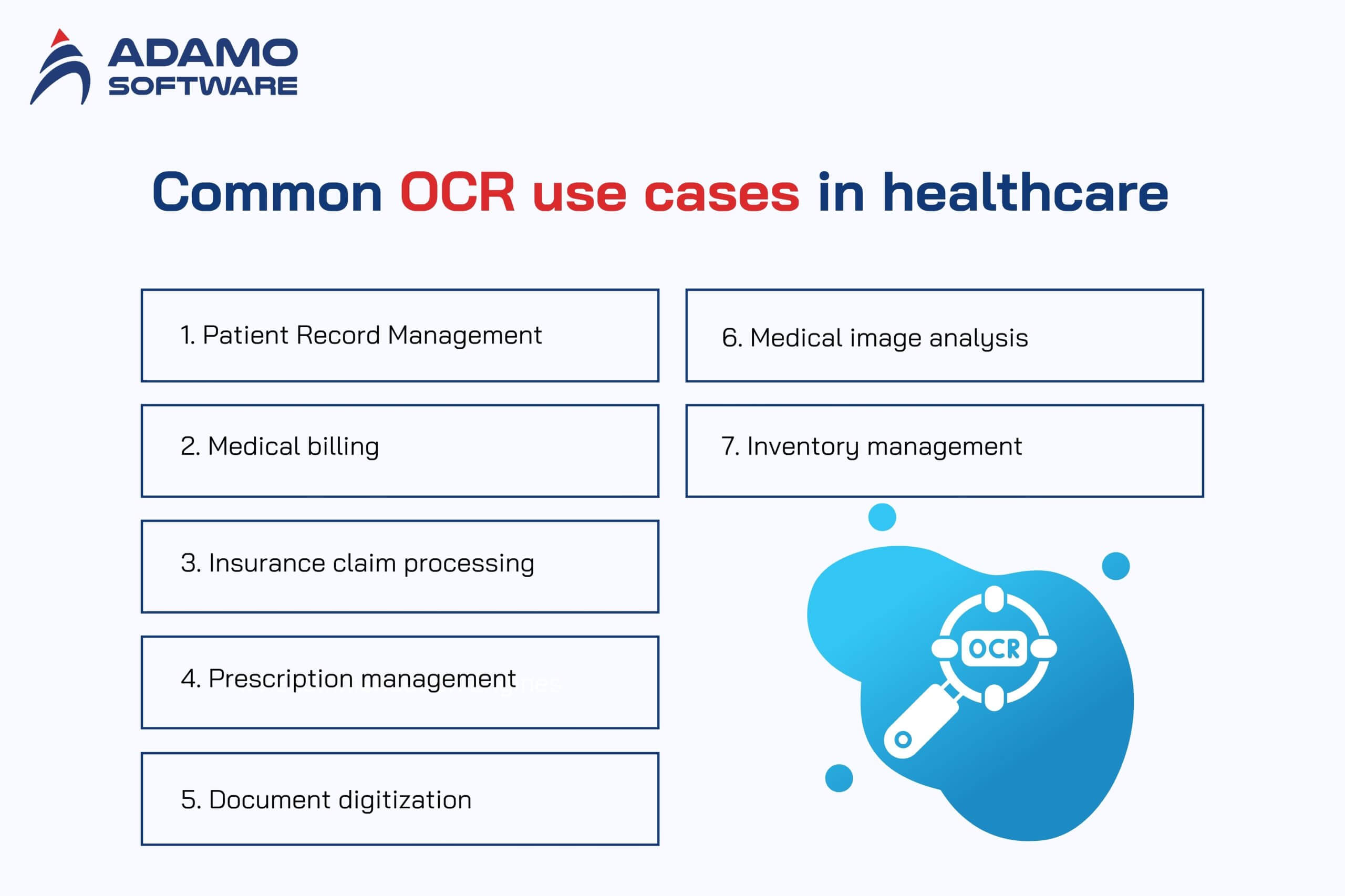
- Patient record management – Data storage, record management, and regulatory compliance
- Medical billing – Extract Medical Record Data for Billing Profile
- Insurance claim processing – Accelerating healthcare claims processing
- Prescription management – Ensuring consistency in care and preventing medical errors
- Document digitization – Shortening the time to convert data
- Medical image analysis – Recognizing the images and detecting abnormalities
- Inventory management – Preventing stockouts and overstocking
Let’s learn about each case with Adamo Software!
Patient record management
The OCR in healthcare can be adopted for patient record management. Managing patient records is critical to delivering accurate care, complying with standard regulations, and ensuring security. The OCR platform collects relevant data such as patient names, addresses, phone numbers, diagnoses, genetic issues, recommended medicines, and treatment protocols from patient forms, reports, and prescriptions. The collected data can be transferred to other medical software to manage patient records, ensure secure storage, and maintain regulatory compliance.
Medical billing
Due to its complexity, medical billing requires meticulous accuracy and knowledge of medical codes and insurance policies. An OCR in healthcare model can be trained to streamline this process by pulling specific patient data from document, including diagnoses, prescribed medications, and procedures, for use in billing and coding. Accurate and rapid bill data extraction using an OCR solution optimizes the medical billing process.
Insurance claim processing
Insurance claim processing is also another adoption of OCR in healthcare. To handle the high-volume processing of daily health insurance forms, agencies can use OCR to quickly and accurately extract data. The data includes:
- Patient details: Patient name, address, date of birth, insurance policy number, and gender
- Provider details: The healthcare provider’s name, qualifications, specialization, and hospital or clinic location
- Medical codes: Industry-recognized ICD and CPT codes related to diagnoses and treatments
- Financial details: Income, total bill amount, co-pays, and reimbursement amounts
By providing efficient data extraction, OCR accelerates healthcare claims processing, which helps reduce claim rejections and ensures faster reimbursements for healthcare providers.
Prescription management
OCR in healthcare can be used for prescription management. Maintaining consistency in healthcare treatments and preventing potential mistakes is crucial to effective prescription and medication management. OCR automates this process by scanning prescription forms and extracting key details like medication names, dosages, and other treatment protocols.
Document digitization
OCR in healthcare can automate document digitization by extracting vital patient data from multiple sources and converting them into a standardized digital format. This process takes only 45-60 seconds, a significant improvement over manual data extraction, which can take days or weeks.
Medical image analysis
AI-powered OCR in healthcare solutions are primarily used in medical image analysis to effectively analyze CT scans, MRIs, mammograms, brain scans, and X-rays. Using computer vision and deep learning algorithms, it recognizes images and can detect even the slightest abnormalities, like lesions and bone thinning.
For example, AI-enabled OCR solutions with machine learning can assist in the early diagnosis, prevention, and management of cancer. By training the model with images of malignant and benign tumors and shuffling them periodically, you can verify its accuracy in detecting cancer growth.
Inventory management
By optimizing hospital inventory, OCR ensures that healthcare providers have the resources they need for their practice. By recognizing barcodes, invoices, and medicine labels, the system extracts critical information such as stock levels and expiration dates.
Through ML and NLP, OCR in healthcare solutions can effectively analyze historical data and patient behaviors to identify trends and patterns, which helps healthcare facilities anticipate future demands and make informed decisions. Such analysis can prevent stockouts and overstocking and streamline inventory processes.
V. Final thoughts
In conclusion, OCR in healthcare plays a vital role in digital transformation, helping to optimize processes, reduce operating costs, and improve patient care through automation and efficient data management. However, this technology still faces challenges in storage, security, accuracy, and the ability to handle poor quality documents, requiring continuous improvement and AI integration for optimal efficiency.

When correctly implemented, OCR in healthcare not only helps process documents quickly but also allows for in-depth data analysis, which improves the patient experience and boosts the overall efficiency of modern healthcare systems. If you are looking for a partner to help you implement OCR in healthcare, Adamo Software, one of the leading technology companies in Vietnam, can be your ideal choice. Here’s a quick look at how we can help.
- Developing custom OCR in healthcare solutions
- Integrating AI and machine learning
- Integrating OCR into existing healthcare systems
- Providing flexible solutions
- Supporting data analysis and security
Still hesitating whether to choose Adamo Software? Let’s contact us for more detailed information!
FAQs
1. Why is OCR technology essential for optimizing healthcare risk adjustment?
The healthcare industry has been transformed by information technology, with OCR being widely used to convert scanned images or documents into digital text, allowing for quick data extraction and analysis, reducing errors compared to manual data entry. This technology is particularly useful for risk adjustment activities such as coding, billing, and quality reporting, and helps identify high-risk patients accurately. In addition, OCR helps doctors access patient information in a timely manner, improving the efficiency of diagnosis and treatment, contributing to improving the quality of healthcare and reducing unnecessary costs.
2. What is the role of OCR in healthcare risk adjustment?
OCR plays an important role in helping to digitize paper documents, making them easy to manage and access. With the increasing number of patients, OCR supports record keeping, quick processing of insurance documents and minimizing errors due to manual data entry. This technology also improves work efficiency, helping doctors focus on patient care instead of administrative tasks. Deploying OCR brings great benefits in productivity, cost savings and ensures accuracy in medical information management.
3. What is the role of OCR in clinical text analysis?
OCR is a powerful tool that automatically recognizes characters in scanned documents, helping to extract important information like diagnoses, treatment plans, and prescriptions. By providing accurate data, OCR improves the quality of patient care by supporting physician decision-making. The technology also helps reduce manual data entry errors, which saves time processing large volumes of medical information and supports advanced analytics for research. Ultimately, implementing OCR enhances information management, leading to increased productivity, reduced costs, and more comprehensive healthcare support.




